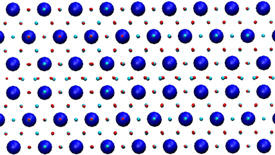

02/23/2015

Reproduced from Ref. 1 and licensed under CC BY 4.0 © 2014 K. P. McKenna et al.
Highly stable ‘antiphase’ defects have finally been conclusively shown to be responsible for the poor spintronic properties of magnetite. While this has long been suspected to be the case, no one has been able to definitively demonstrate it until now.
Magnetite (Fe3O4) has been much studied, being the oldest known magnetic material and one of the most abundant iron-containing minerals on Earth. It is of fundamental interest as well as being used in diverse applications including catalysis, rechargeable batteries and magnetic recording.
In theory, it should be an ideal material for the emerging field of spintronics, which exploits both the charge and spin properties of electrons (unlike conventional electronics, which focuses on their charge properties). This is because all the spin conduction electrons in magnetite are predicted to be spin polarized at room temperature. However, its experimentally measured spin polarization has always been much lower than that predicted by theory. A long-suspected culprit for this discrepancy has been antiphase defects, but no one has been able to definitively confirm this, until now.
In a theoretical and experimental study, Chunlin Chen, Zhongchang Wang and Yuichi Ikuhara from the AIMR along with collaborators at the University of York in the United Kingdom have shown, beyond any doubt, that antiphase defects are responsible for the low spin polarization of magnetite1.
They performed first-principles predictive modeling of the structure of antiphase defects in magnetite. Using this structural information, they were then able to infer the electronic and magnetic properties of the defects. Finally, they used atomic-resolution transmission electron microscopy to resolve the three-dimensional structure of the defects ― the first time this had been done.
They obtained excellent agreement between the model predictions and the experimental results, confirming the role of defects in reducing the spin polarization of magnetite. Wang says that this finding is valuable because it shows “that to improve magnetite for spintronic device applications and achieve 100 per cent spin-polarized materials, we need to remove antiphase defects.” Chen notes that the defects “may find applications in catalysis, since defects usually have higher catalytic activity.”
The modeling technique used in the study is promising for analyzing other systems. “The agreement between the theoretical prediction and the experimental images is remarkable,” says Wang. “The theory came first, demonstrating its predictive power and utility in materials optimization for applications.”
In the future, the researchers intend to investigate the atomic structure and properties of other defects in magnetite, such as twin boundaries.
McKenna, K. P., Hofer, F., Gilks, D., Lazarov, V. K., Chen, C., Wang, Z. & Ikuhara, Y. Atomic-scale structure and properties of highly stable antiphase boundary defects in Fe3O4 Nature Communications 5, 5740 (2014). | article
This research highlight has been approved by the authors of the original article and all information and data contained within has been provided by said authors.